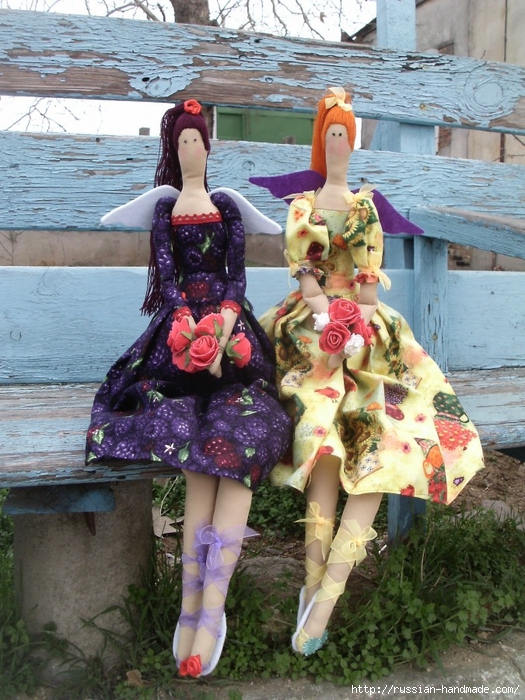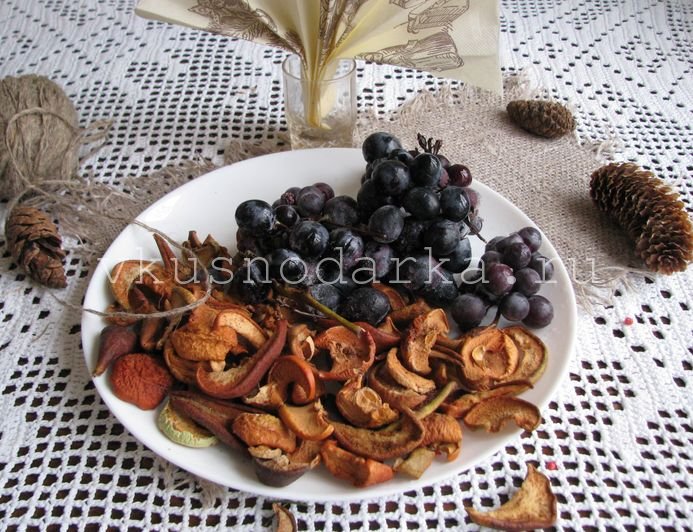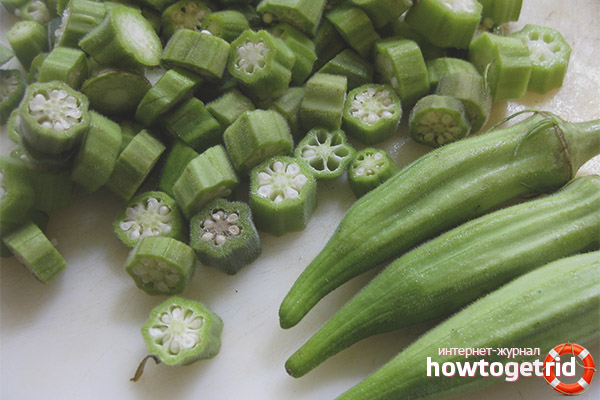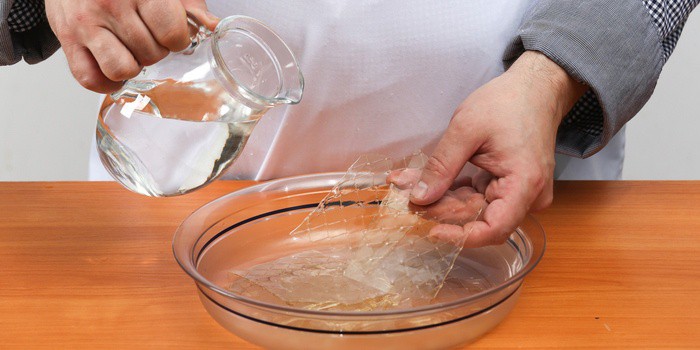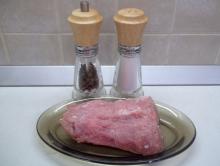How to dye fabric for dolls and toys. Master Class! We paint fabric for Tilda's textile doll

Methods of dyeing fabric in flesh colors for sewing TILDS
Tissue Dyeing - Manganese
Very persistent staining. Things painted with potassium permanganate were washed many times and the color does not wash off. Ikeevskaya White Lenda was used
Very little manganese was poured into the warm water from the tap; the solution turned out to be dark cherry in color. Mix well to dissolve. Put pieces of cloth. I got it right away, after 1,3,6,10,20 minutes, then after 1,2,3 hours (I didn’t forget to stir).
Another double pieces, stained for 1 and 2 hours, dipped in a solution of turmeric. Then it dried, ironed and decorated everything on a sheet. And here's what happened:

Manganese gives a good color, and with turmeric you can make it a little yellower, it turns out pretty. 🙂 Do not forget to wear gloves when painting and stir the fabric in the solution for uniform staining.
Fabric Dyeing - COFFEE
Used soluble pele in a red jar.
Brewed with boiling water (2 options - 1.5 teaspoons per 200 ml of boiling water and 3 teaspoons per 200 ml of boiling water), mixed well to dissolve. Put pieces of cloth. I got it right away, after 1,3,6,10 and 20 minutes (I didn’t forget to stir). I dried it, ironed it, and then decorated everything on a sheet. And here's what happened:

The colors turned out good, bright, warm. In reality, the gradient from piece to piece is better visible. Although this scan is closest to the original. Where coffee is thicker, the color is a bit more saturated.
In the third version with turmeric coffee. Oh, and a vigorous thing! 🙂 With her, she came to the conclusion that if the fabric turned out with a gray tint (it can also be from coffee or tea) and I want to make it a little warmer, yellower, then after staining in tea / coffee you need to quickly dip the fabric in a solution of turmeric. Dry, see - if yellow is not enough, then dip again. Because when you are in a solution with turmeric for a long time, the fabric becomes very yellow in color, and if you do it this way quickly, you get a neat tint in yellow. Yes, and don’t forget to wear gloves when you paint!
Fabric Dyeing - TEA
I needed to dye the fabric in a flesh-colored shade for my needlework. I tried different methods and as a result, whole “color cards” were compiled - a useful and necessary thing in needlework. 🙂
Today I’ll show you what happened with tea. Used the "Princess Nuri Alpine" packaged.
At home there was Ikeevskaya white in Lenda. It is a dense cotton, well suited for sewing bodies for toys like Tilda.
Tea was brewed and insisted for 5 minutes under the lid (2 options - 2 bags per 200 ml of water and 4 bags per 200 ml of water), squeezed the bags, threw them away, dipped the fabric into the tea leaves. Then immediately or after 1.3.6 minutes the fabric was taken out, Rinsed in cool water and dried, spread out on a towel. And then she ironed and looked what would happen.
She also experimented with pure turmeric and added to tea.
I registered the result in such a tablet:

Scan turned out closest to the original. 🙂 Unpainted fabric is highlighted in red.
For uniform staining do not forget to stir and move the fabric. Otherwise, tea will settle to the bottom (and turmeric too) and stains will appear on the fabric. For samples, I did not particularly need this, so my tissues are partially striped. 🙂
Use the tea dyeing method to give a new look to kitchen towels, T-shirts and any other fabric items without much hassle and expense. Tea cannot radically change the color of white fabric, but it helps to hide light spots and give things an old look. The tea method is suitable for everyone who has the opportunity to boil water.
Steps
Part 1
Make tea-
Brew tea in water. After boiling, remove the pan from the heat and place tea bags in the water. Let the tea brew so that it fully renders color. In most cases, this will take at least 15 minutes.
- The longer the tea is infused, the more saturated the color of water and colored fabric will be. Before placing the fabric, make sure that you are comfortable with the color of the water.
Part 2
Immerse the cloth in water-
Wash or dampen the cloth. By the time of painting, the fabric should be wet. Wash previously used cloth to get rid of stains and dirt. If you are using a new cloth, soak it in advance with water and then wring it out.
- Tea can only be dyed with natural fibers such as cotton, silk, linen and wool. All synthetic fabrics like polyester are not suitable for this type of dyeing.
- Before painting, the fabric should be wrung out, but not dried.
-
Remove the bags and place the cloth in water. If the tea has already colored the water in the desired color, then carefully remove all the bags from it. They will no longer be useful. Place a damp cloth in the pan and make sure it is completely under water.
- Use a wooden spoon or other tool to distribute the cloth in the pan and submerge completely.
- Some sections of tissue will begin to float. Submerge them under water with a spoon.
-
Leave the fabric in solution for at least one hour. After immersing all the tissue in the pan, leave it in solution for at least 60 minutes. The longer you hold the fabric in tea, the more saturated the color will become.
- You can leave the fabric in solution overnight to make sure the color is saturated.
- It is recommended to periodically stir the fabric so that the color is evenly distributed on its surface.
- You can occasionally remove the fabric from the solution and check the color. It is important to understand that dry tissue will turn out to be lighter than wet, so sometimes it takes more time than it seems at first glance.
Part 3
Rinse and dry the cloth-
Rinse and leave the cloth in cold water with vinegar. After the fabric has dyed the desired color, remove it from the tea solution. Rinse quickly in cold water and then leave for 10 minutes in a container of cold water. Add some vinegar to the water to fix the color.
- If you are concerned about the tea smell of the fabric, wash it by hand with a mild detergent to get rid of the smell.
Remove tea bags from packages and cut the threads. Expand the packaging of each bag and cut the threads with scissors.
Boil a large pot of water with salt. There should be enough water in the pan so that you can immerse and freely move the cloth in it. Add salt to the water and place the pan on the stove. Turn on a strong fire and bring the water to a boil.
In my method, I put together several techniques tinting coffee toys, and the option turned out, it seems to me, the most optimal for a beginner. Toning is even, the seams are clean.
For tinting toys with coffee mix with PVA You will need:
- objects for tinting,
- instant coffee (the cheapest, granular or powder - it doesn’t matter)
- warm water
- pVA glue,
- ground cinnamon (optional),
- a synthetic flat wide brush (many tint with a foam sponge, but it somehow went wrong with me),
- old waffle towel.
First, prepare tinting mixture for textile (coffee) toys: ground coffee, water and PVA glue.
In a cup we put 1-2 full tablespoons of instant coffee (granular - you can immediately 1.5-2, powder - start with 1 spoon, as it gives a more saturated color, you can always add if you want), add a little cinnamon. Here we proceed from my preferences, I like the smell of cinnamon, so I put almost a third of a teaspoon.
Pour all this with about 50 ml of warm water and mix well. She did a little more, so she increased the dosage exactly 2 times.
In 50 ml of water we put 1 full tablespoon of PVA and carefully knead until a homogeneous consistency. The more PVA glue is, the tougher the fabric will be “woodier" after drying. 1 tablespoon is enough, the toys are moderately tough and this amount is enough to subsequently apply paint to the fabric.

Vanilla is not added to the solution, otherwise crystals will be visible on the fabric. We add it either at the stage of stuffing the toy inside, or slightly lubricate the back of the finished product.
Slightly dip the brush into the solution, squeeze it on the edge and from the middle of the toy begin to tint the fabric moving in the direction of the seam. So, an almost dry brush will come to our seam, because if the stitch gets wet so bad, stains will remain.


And the other side ...
To control after tinting, I always immediately dab the toy with a waffle towel, it will absorb the excess solution, if any.

Many dry toys in the microwave, but I did not like this option, it happened that there were unwanted spots, so I dry in a natural way: I put the whole batch on batteries. It is very convenient, as the coffee makers touch a little with their legs and a little with their ears on top. And in winter, another plus, they dry faster. 🙂

Like this…

I will show for example the most "treacherous" places, it turned out quite accurately.


We paint the finished toy with acrylic paints on the fabric.

Shovchiki, if desired, can be tinted. Here, too, have their own nuances.
I also tint with a flat synthetic brush, which I first rub to dry on a piece of paper.



Here is the result ...

Larger ...


Attention: coffee toys must not be washed and taken with wet hands !!!
I was glad to help!
An easy way to try dyeing the fabric at home is to take an ingredient such as coffee, which you probably already have at home. To stain the fabric with coffee, you will need only a few simple items, which most likely are also in your kitchen cabinet. It is best to use natural fabrics such as cotton, wool or linen. The whole process of dyeing is quite fast and relatively accurate, while it allows you to change the appearance of almost any fabric as you see fit.
Steps
Dyeing the fabric with coffee
- As an alternative to brewing several servings of grain coffee at home, you can use instant coffee or purchase ready-made coffee at a nearby cafe or coffee shop. However, the latter option will cost you significantly more.
-
Fill the pan with water. Put it on the stove and turn on a strong fire or heat.
- The size of the pan will depend on how much fabric you are going to dye. The usual rule is that the entire fabric can be completely immersed in water.
-
Add brewed coffee to the pan. When you are finished brewing coffee, pour it into a pot of water.
Bring the composition to a boil. After you add all the prepared coffee to the pan, bring the coffee solution to a boil. Turn off the burner as soon as the composition boils well.
Immerse the cloth in the pan. When you turn off the hotplate and the coffee stops boiling, completely immerse the cloth in it. Gently stir the damp cloth in the pan to release any air pockets from it.
- Since the coffee solution has just stopped boiling, it is probably best to use a wooden spoon so as not to burn yourself and spoil other kitchen utensils.
-
Leave the fabric to soak in the coffee solution. The longer the fabric will be in it, the richer the resulting color. It will take you about an hour to get a noticeable stable staining result, but you can leave the fabric in solution for a longer time to get an even deeper shade.
Remove the cloth from the pan and rinse. Remove the fabric from the coffee composition and carefully place it in cold water. Do this until clear water flows, which will indicate the removal of all excess coloring matter.
Rinse the pan. When finished dyeing the fabric, rinse the pan. Coffee can lead to discoloration of the pan if it is not drained promptly after the staining procedure and the dishes are not washed.
Wash the cloth with a mild detergent and dry. Set the washing machine to delicately wash in cold water and add gentle detergent to it. After washing, the fabric can be dried in a dryer with a little heat or just hung to dry in the shade.
- The above method of staining with coffee will not give you a completely stable result, since coffee is a natural dye, the color of which is gradually washed out with each wash.
Rubbing coffee grounds
-
Wash the fabric first. Wash the fabric before dyeing, but do not dry it. This will remove grease and other contaminants that may interfere with uniform staining of coffee grounds.
-
Make coffee. You will need thickened from brewed coffee beans. To get coffee grounds, you can use a French press or a coffee maker.
- You will need a large enough amount of coffee grounds to cover with it the entire area of \u200b\u200bthe fabric to be dyed. Probably, for this it will be necessary to brew coffee several times.
- Take dark roast coffee to darken the fabric, or use a lighter roast if you don't want to make the fabric very dark.
- This is a great way to use coffee grounds. If you regularly drink coffee beans, then for this method of staining, you can gradually accumulate the required amount of grounds.
-
Make coffee grounds pasta. When the coffee grounds have cooled, place them in a large bowl and then add water there. You will need approximately one tablespoon of water for each glass of coffee grounds.
- Mix coffee grounds with water with a wooden spoon to moisten the composition evenly. Ground coffee is not so small, so it will be enough to prevent the paste from only 7-8 times.
-
Apply coffee grounds paste to the fabric. Lay the fabric to dry on a waterproof surface. Be sure to completely cover the coffee grounds material and rub it. This can be done with a wooden spoon or similar kitchen utensils or you can simply rub coffee paste with your hands.
- The whole process is not very neat, so it’s better to do it where it’s not scary to create some kind of mess, for example, in a garage. You can also simply protect the floor or carpet with a thick layer of newspaper.
-
Dry the cloth. Hang the fabric to dry in a shaded area. You need to wait until it is completely dry. This can take from several hours to whole days. You can also dry the fabric in a dryer with low heat for 30 minutes.
Remove coffee grounds from the fabric. You can do this with your hands, use a brush with natural bristles, or simply shake the cloth to remove all the grains of coffee grounds. If the fabric is not dark enough, repeat the procedure until the desired effect is achieved.
Iron the fabric if desired. An iron will smooth out the crumpled fabric.
- For best results, the fabric should be completely dry when you iron it with a hot iron.
Tai Dye Staining
-
Wash the fabric first. Before dyeing the fabric using the Tai Dai technique, wash the fabric in the usual way. This will remove fatty and other contaminants that may interfere with the uniform absorption of the dye composition into the fabric.
- The fabric can be washed with other clothes or individually (depending on your own preferences).
- Be sure to follow the instructions for washing the fabric (if any).
-
Make coffee. The amount of coffee you need to brew will depend on how dark you want the fabric to be. Stronger coffee allows you to get a darker coffee shade.
- If you need to dye the fabric a very dark coffee color, take more coffee or use dark (strong) roast coffee. If you need a light coffee shade, take less coffee or use light or medium roasted coffee.
- As an alternative to brewing several servings of grain coffee at home, you can use instant coffee or purchase ready-made coffee at a nearby cafe or coffee shop.
-
Wait for the coffee to cool. It can be refrigerated for 20 minutes or just wait a couple of hours, leaving coffee at room temperature.
- Then place your finger in the center of the fabric (or things) and start turning it clockwise with your hand. Depending on the size of the fabric, you may need a plastic container or a bag with a zip fastener. Close the bag or container and put it somewhere in a warm place for 24 hours.
- Coffee allows you to achieve a light fabric from light to medium-dark brown. If you want to get a warmer reddish tint, you can use the same methods, but replace coffee with tea.
- Pre-check the staining result on a test tissue sample. This will allow you to evaluate the likely staining effect without the risk of accidentally spoiling your entire fabric.
Warnings
- Staining coffee grounds is a rather dirty process, so be sure to ensure that you are able to reliably protect the floor or carpet on which you will work.
- Staining coffee grounds can cause scuffs on the fabric, so avoid this method if you want to keep the fabric intact.
Wash and dry the fabric in the usual way before dyeing the fabric. This will eliminate fatty and other contaminants that may interfere with the uniform absorption of dyes into the material.
Make coffee. The amount of coffee you need to brew will depend on how dark you want the fabric to be. The stronger the coffee, the darker the shade.
Before, I once only thought a couple of times about the fact that you can dye the fabric at home.
Somehow it was no reason.
Although, now I don’t really need it (no, I dyed the lace a couple of times with tea leaves но), but one of my readers is fond of the Tilda doll, and for her she dyes fabrics at home, and even with natural dyes.
I was very glad when she kindly provided a workshop on dyeing fabrics.
How you can dye a fabric, how to dye a fabric for tilde and how to dye a white fabric - you will find the detailed answer below for all these questions.
Materials:
Flax cuts - 3 pcs.;
Ground coffee - 1 tbsp. spoon;
Ground cinnamon - 1 tbsp. spoon;
Onion peel - 2 presses.
Any craftswoman knows how important it is to have fabrics of different colors and shades on hand: when the choice is great, you can easily choose the material for any idea. Here, dyes come to the rescue - not only artificial, but also natural. Ordinary cinnamon, ground coffee and onion husks will help us to create fabric of interesting shades.
How and how to dye the fabric at home:
1. First, try to dye a piece of flax with cinnamon. The fabric dyed with this seasoning is especially loved by the craftswomen who sew tilda toys. The fact is that cinnamon gives the fabric a very delicate shade, and in the future this fabric can be used to create doll faces. For coloring we take light flax - on it the effect of coloring will be better visible.
So, put a spoonful of cinnamon in a pan, fill it with two glasses of water and bring to a boil. As soon as the liquid boils, we put in it a piece of tissue and cook for 10 minutes.
2. After 10 minutes, remove the flax from the water with cinnamon, rinse under cold running water and dry. We get a beige fabric with an interesting gingerbread tint.
3. Now try to dye the fabric with coffee. Pour a tablespoon of ground coffee with two glasses of water and bring to a boil. Then we put in it a prepared section of flax and cook for 10 minutes, as is the case with cinnamon.
4. After 10 minutes, we take out a cloth from coffee water, rinse thoroughly in cold water and dry it. The color of the coffee gave a similar color, but after cooking in cinnamon, the fabric looks more pinkish, and after brewing in coffee - more brown.
5. Onion husk do a little different. Fill it with two glasses of water, bring to a boil and boil the liquid for 15 minutes, until we get colored water. Only now can we put a piece of fabric in the water. Cook it with onion husks for 10 minutes.
6. We take a piece of flax from the water, rinse and dry. We have got a flax of saturated sand color.
As a result, we see three cuts of fabric in new shades that we can use to sew delicate dolls or toys. A whole palette of fabrics can be obtained using natural dyes!
P.S. And I also want to add from myself that these skills in dyeing fabrics can be applied not only for tilde dolls, but also for other purposes. For example, I dyed white lace to a cream color using tea leaves. To do this, I brewed several tea bags of black tea (to make strong), and then soaked the lace in this liquid. Color can be varied by holding time 🙂
Thus, knowing a certain skill (not only dyeing fabric at home), you can apply it for different purposes!

